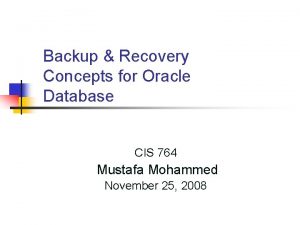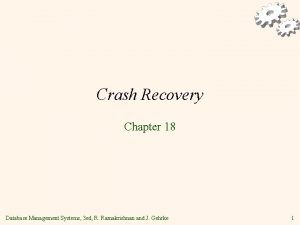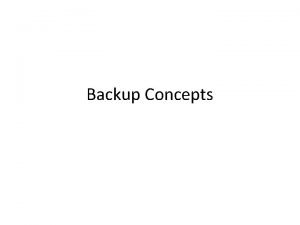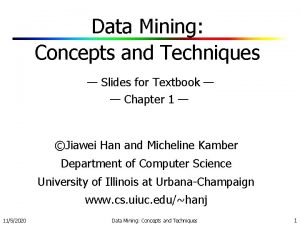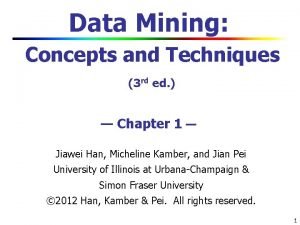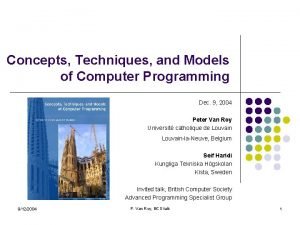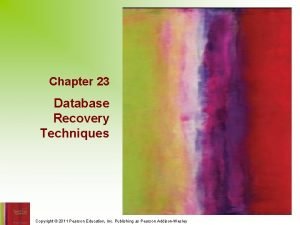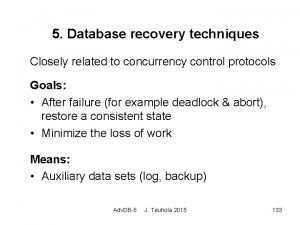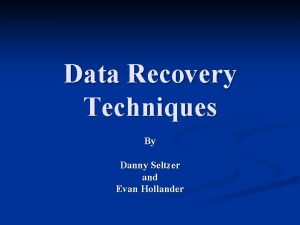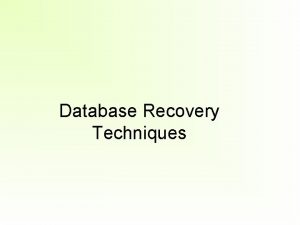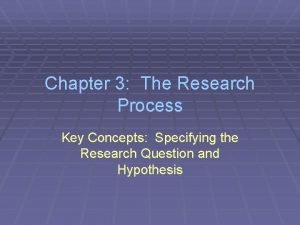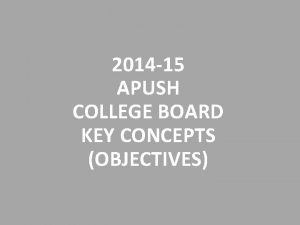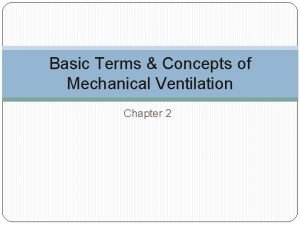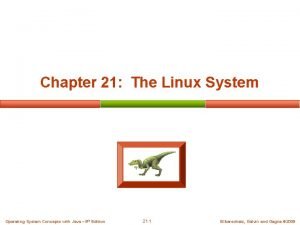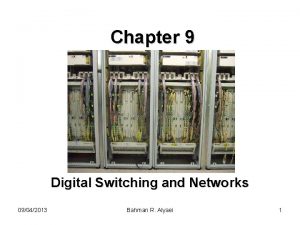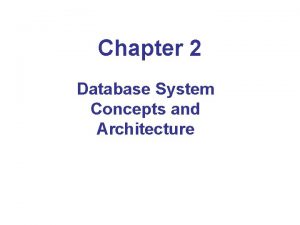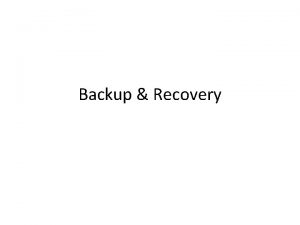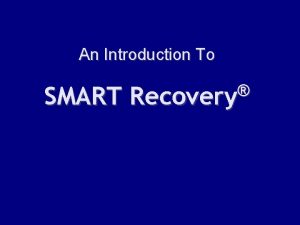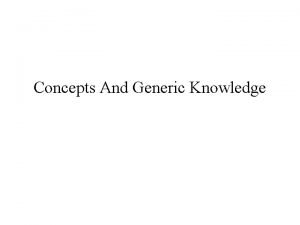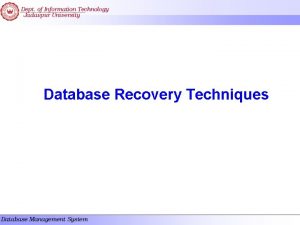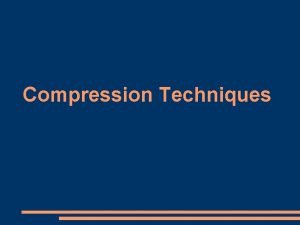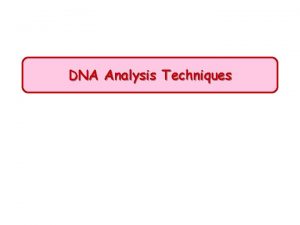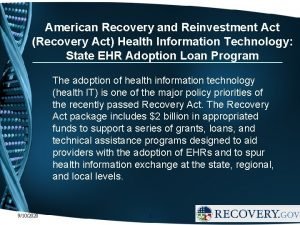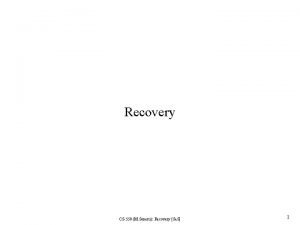Recovery Techniques 1 Recovery concepts 2 Recovery techniques



























- Slides: 27

Recovery Techniques 1. Recovery concepts 2. Recovery techniques based on Deferred Update – No-UNDO/REDO 3. Recovery techniques based on Immediate Update – UNDO/REDO 4. Shadow paging (No-undo/No-redo) 5. Recovery in multidatabase transactions

Database Recovery 1. 1 INTRODUCTION – Nothing can work perfectly 100% of the time. – In system R, approximately 10% of the code is devoted to recovery; moreover, that 10% was quite difficult to write. In IMS, the figure is even larger. – Recovery: Restoring a database to a correct state from an incorrect state caused by some system failure. – Possible failures: » programming errors in an application , OS, or DBMS, » H/W errors on a device, channel, or CPU. » operator errors » fluctuations in a power supply, » fire in the machine room, » etc.

• Solution for recovery: redundancy – any piece of information in a DB can be reconstructed from some other information stored redundantly somewhere else in the system. • What are the disadvantages of duplicating a DB for recovery? – – need twice as much storage have to operate two DBs simultaneously two DBs should have independent failure modes? . . .

• Roughly speaking, a recovery procedure can be outlined as follows: – periodically, the entire DB is copied to archive storage (tape), – every change to a DB is written to the log, which contains the old and new values of the changed item, – if a failure occurs, there are two possibilities: » The DB is damaged: • restore DB by copying it from the most recent archive copy • redo all changes, using the log, to the DB copy. » The DB is not damaged but its contents are unreliable (e. g. incorrect S/W: • restore DB to a correct state by using the log to undo all ”unreliable” changes. The archive copy is not needed in this case.

Types of failure: – Transaction-level failures detectable by the application code (e. g. , INSUFFICIENT FUNDS in TRANSFER) – Transaction-level failures undetectable by the application code (e. g. , arithmetic overflow) (1. 3) – System-wide failures: cause no damage to DB (1. 4) – Media failures: cause damage to DB (1. 5)

1. 2 TRANSACTIONS A unit of work; it consists of the execution of an application-specified sequence of operations. application program: . . BEGIN TRANSACTION . . COMMIT or ROLLBACK (one of them) – an application program can have several transactions – a transaction cannot be partially successful. It is atomic.

Reliability: – If a transaction succeeds, good; – If it fails, then nothing should be done (the effect should be as if it had never started). – If a transaction is executed, it is in effect executed exactly once. – Reliability of a DB is provided by the recovery manager. Messages: – Transaction termination is planned (commit or rollback) ==> message displayed – Transaction termination is unplanned (e. g. , overflow) ==> system-generated error messages should be automatically displayed (==> output messages should not be transmitted until the end of transaction.

– To implement this: » use a queue to pend the output message » on planned termination ==> transmit the message » on unplanned termination ==> discard the message – Data communication (DC) manager handles messages and the queue. – Tasks of DC manager: » on receipt of an input message (e. g. , transfer. . . from. . . to. . . ) • writes a log record containing the input message • places a message on the input queue » on planned termination: • write a record on the log (commit or rollback) • arrange for transmission of output message (or cancel the output message on unplanned termination) • remove input message from the input message queue

1. 3 Transaction failures (unplanned) – For example, arithmetic overflow, memory overflow, bugs in system software, . . – A rollback for a transaction failure is to » cancel output messages the transaction has produced » undo changes made by the transaction to DB • by working backward through the log until the BEGIN TRANSACTION record is reached On-Line Log: 200 Mbytes of log data may be generated per day => impossible to keep the entire log on-line. But from performance point of view, to keep log data on direct access device is necessary. BFIM(Before image): the old value of a data item before update. AFIM (After image): the new value after update.

Write-ahead log: The log entry must be flushed to disk before the BFIM is overwritten with the AFIM. Rollback: Undo changes made by the transaction to DB by working backward through the log. REDO/UNDO Logic: – A rollback is subject to failure too. Therefore, the recovery manager may need to redo/undo an update for multiple times. REDO(…(X))) = REDO(X) UNDO(. . (X))) = UNDO(X) That is Rollback(…. . (Transaction))) = Rollback(Transaction) Long Transactions: – A transaction should be short to reduce the amount of undoing and redoing work. => it is good to subdivide a long transaction in an application into multiple transactions with explicit COMMITs.

Log Compression: For the sake of reducing storage requirements and speeding up later use of log data for recovery. – For transactions that failed to COMMIT, their log records are unnecessary since those transactions have already been rolled back. – For transactions that did COMMIT, the old data values are of no use since undo will never be needed. (But REDO may be required in case of system failure in which new data is still needed. ) – Changes can be consolidated: +2+3+4 => +9



1. 4 SYSTEM FAILURES – System failure: A failure causes system to stop and requires a subsequent system restart. Main storage contents are lost, but DB is not damaged. – Action: » Transactions that were in progress at the time of failure must be rolled back (undone). » Transactions that were complete but not written to secondary storage need to be redone. – Problem: How do we know which transaction to rollback and which to redo? It is too costly to search the BEGIN TRANSACTION and COMMIT (or ROLLBACK) from the very beginning of the log.

Checkpoint A checkpoint record has • All transactions active at the time of checkpoint • The address of each transaction’s most recent log record. Checkpoint actions: 1. Suspend execution of transactions temporarily. 2. Force-write all main memory buffers that have been modified to disk. 3. Write a [checkpoint] record to the log, and force-write the log to disk. 4. Resume the executing transactions. New technique: “fuzzy checkpoint” allows the system to resume transaction processing after the checkpoint record is written to the log without having to wait for Step 2 to finish.

Idea: 2. Recovery based on Deferred Update To defer updates to the DB until the transaction completes its execution successfully and reaches its commit point. During transaction execution , the updates are recorded only in the log and in the cache buffers. After the transaction reaches its commit point and the log is force-written to disk, the updates are then recorded in the DB. The protocol 1. A transaction cannot change the database until it reaches its commit point. 2. A transaction does not reach its commit point until all its update operations are recorded in the log and the log is force-written to disk. Because the DB is never updated until after the transaction commits, there is never a need to UNDO any operations. Hence, it is known as a No. UNDO/REDO algorithm. No-Undo: if transaction fails before commits. Redo: if transaction fails after commits but not force-written to disk yet (controlled by OS).

2. 1 Single-user environment Algorithm • REDO all the write_item operations of the committed transactions since the last checkpoint from the log in the order in which they were written to the log. • Resubmit the active transactions. REDO(Write_OP) • Access the operation’s log entry [write_item, T, X, new_value] for data item X of transaction T. • Set the new_value to X.

Deferred Update – Single user environment

2. 2 Multiuser environment Algorithm Same as that in the single-user environment. Do nothing redo Do nothing

• Advantages: – No need of undo • Disadvantages: – Only suitable for transactions that are short and change few items, because transaction changes must be held in the buffers until the commit point.

2. 3 Transactions that do not affect the DB Transactions include generating and printing messages or reports from information retrieved from the database. These actions should not be done if a transaction fails. Hence, these actions are done after the transaction reaches its commit point.

3. Recovery techniques based on Immediate Update When a transaction issues an update, the DB can be updated immediately without waiting for transaction commit. (Certainly, an update operation still must be recorded in the log (write-ahead log protocol) before the update is applied to DB. ) Types: • All updates of a transaction are recorded in the DB on disk before the transaction commits Undo/No-Redo. • A transaction is allowed to commit before updates are written to DB in disk (i. e. , updates of a transaction may or may not be recorded in the DB on disk before the transaction commits). Undo/Redo (the most complex technique – we only present this one)

3. 1 Undo/Redo recovery based on Immediate Update in a single-user environment Algorithm • Active transactions: UNDO all the write operations since the last checkpoint from the log in the reverse order. • Committed transactions: REDO all the write operations since the last checkpoint from the log (because some write op may not have been written to disk).

3. 2 UNDO/REDO Immediate update with concurrent execution Algorithm: same as that in the single-user environment. Do nothing redo undo

4. Shadow paging (No-Undo/No-Redo) When updating database, the AFIMs are written to a new location different from that of the BFIMs. Two tables are used: • Current page table: pointing to the most recent DB pages on disk • Shadow page table: pointing to the DB pages before transaction execution. While crash occurs: discard current pages; back to the state before transaction executes (using the data referenced by the shadow page table); hence, No-Undo. While transaction commits: discard shadow pages; hence, No-Redo.

Advantages: no redo and no undo. Disadvantages: the sizes of tables can be large; garbage collection is needed.

5. Recovery in multidatabase (distributed DB) systems A global recovery manager or coordinator is needed in addition to local recovery managers. Two-phase commit protocol: • Phase 1: Voting phase A global transaction is decomposed to subtransactions, each executed in a local DB. If each locate DB executes its subtransaction successfully (having force-written log records into disk), it sends an “OK” signal to the coordinator. Otherwise, the local database sends a “not OK” to the coordinator. • Phase 2: Commit phase If the coordinator receives “OK” from all participating DBs, it sends a “commit” signal to all the DBs to commit the transaction. If any of the local DBs says “not OK”, then the coordinator sends an “abort transaction” (or rollback) to the DBs to undo the transaction.
 Backup and recovery concepts
Backup and recovery concepts Lsn in dbms
Lsn in dbms Backup concepts
Backup concepts Data mining concepts and techniques slides
Data mining concepts and techniques slides Data mining concepts and techniques
Data mining concepts and techniques Data mining concepts and techniques slides
Data mining concepts and techniques slides Data mining concepts and techniques
Data mining concepts and techniques Concepts techniques and models of computer programming
Concepts techniques and models of computer programming Recovery techniques based on immediate update
Recovery techniques based on immediate update Database recovery techniques
Database recovery techniques Recovery techniques based on immediate update
Recovery techniques based on immediate update Disaster recovery techniques
Disaster recovery techniques Immediate update and deferred update in dbms
Immediate update and deferred update in dbms Magnetic force microscopy data recovery
Magnetic force microscopy data recovery Database recovery techniques
Database recovery techniques Fonctions et solutions techniques
Fonctions et solutions techniques Professional nursing practice concepts and perspectives
Professional nursing practice concepts and perspectives Key concepts in research
Key concepts in research Apush college board key concepts
Apush college board key concepts Transairway pressure
Transairway pressure 10 accounting concepts
10 accounting concepts Linux operating system concepts
Linux operating system concepts Apush period 5 key concepts
Apush period 5 key concepts Difference between tst and sts switch
Difference between tst and sts switch Database system concepts and architecture in dbms
Database system concepts and architecture in dbms It concepts
It concepts Basic concepts of research
Basic concepts of research Higher music concepts
Higher music concepts
